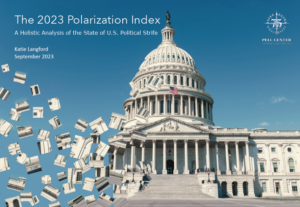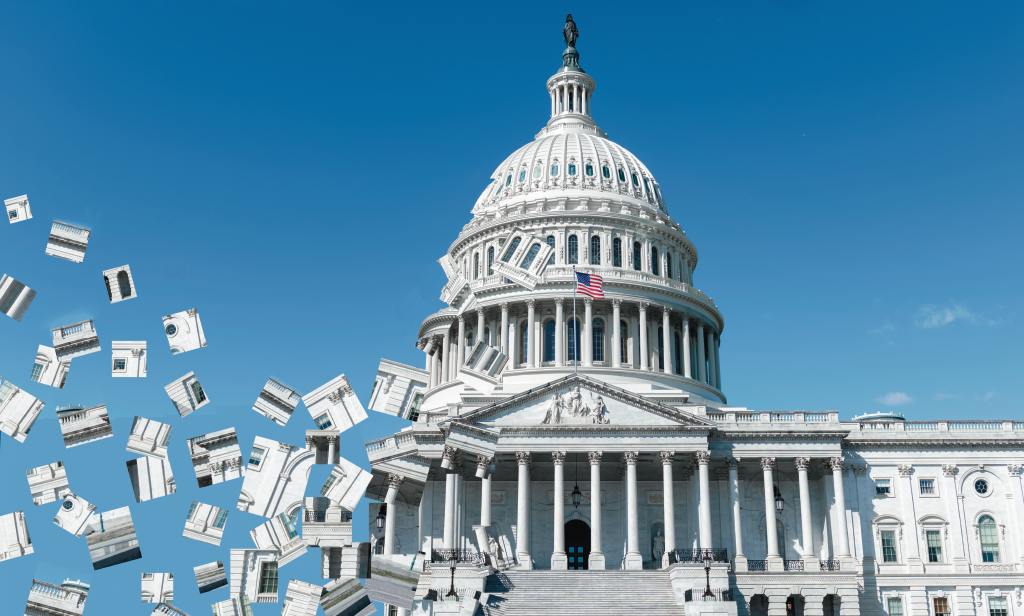Americans Want Bipartisan Solutions, But the U.S. House of Representatives is Passing Partisan Legislation at a Historic Rate
October 23, 2023
NEWPORT, RI—The partisanship and political in-fighting plaguing Congress amidst a historic leadership crisis in the U.S. House of Representatives stands in sharp contrast to the desires of the American public, according to new research from the Pell Center at Salve Regina University.
As part of its new “Polarization Index,” the Pell Center analyzed legislation passed in Congress to understand the history of the legislative branch’s ability to work in a bipartisan manner. The study provides bipartisan scores for every session of Congress between 1945 and 2022, placing every piece of substantive legislation passed on a tiered scale: very bipartisan, bipartisan, somewhat bipartisan, and not bipartisan.†
In fact, Congress has a long history of passing bipartisan legislation. From 1961 to 2008—a span of 47 years—the majority of legislation passed in both the House and the Senate was bipartisan, with one exception (the 104th House).
In the last decade, however, the Senate and House have hit record highs for the percent of partisan legislation passed. In the 117th Senate (2021-2022), 54% of the legislation passed in Congress was partisan, meaning the majority party forced through over half of the legislation. This was the highest percentage of partisan legislation recorded in the Senate between 1945 and 2022.
The House reached a record high of partisan legislation during the 114th Congress, 2015-2016, at 55%. Since then, the percent of bipartisan legislation has increased, landing at 44% in the 117th Congress, 2021-2022 (compared to 41% of partisan legislation). That progress may be backsliding, however. Of the 136 pieces of legislation and amendments passed in the House so far in 2023, 79% were partisan – the largest percentage of partisan legislation ever recorded in either the House or the Senate.

Bipartisan scores fell between 0-1: not bipartisan (0-0.25): majority party overwhelmingly voted ‘Yea’ and nearly all opposition voted ‘Nay;’ somewhat bipartisan (0.26-0.5): more than three-quarters of one party and about one-third of the other voted ‘Yea;’ bipartisan (0.51-0.75): nearly all of one party and over two-thirds of the other party voted ‘Yea;’ and very bipartisan (0.76-1): the majority or entirety of each party voted ‘Yea.’ For more information, see page 15 of Part III of the Polarization Index.
These high percentages of partisan legislation come at a time when most Americans, regardless of their political party, want government officials to compromise to find solutions to America’s most pressing issues (Marist, 2022). Over 85% of Democrats and Republicans want Congress to pass bipartisan legislation on the economy, healthcare, immigration, and criminal justice (Morning Consult and Bipartisan Policy Center, 2022).
“This data takes on new urgency while the House is effectively shut down without a speaker,” says Katie Langford Sonder, Associate Director of the Pell Center and author of the study. “A small majority of political elites have stopped the normal functions of our legislative system at a time when Americans have little confidence in the government but want to see compromise and progress.”
The research is presented in Part III of the “Polarization Index: A Holistic Analysis of the State of U.S. Political Strife” which Sonder authored for the Pell Center at Salve Regina University. The four-part series uses national data to understand how politically polarized Americans are on the most pressing issues of the day. Parts I and II, which were published last month, can be downloaded here. Part IV, the final installment, will be published in December 2023.

Katie Langford Sonder is the Associate Director of the Pell Center at Salve Regina University and directs the Center’s research agenda, contributing her own scholarship while supporting the work of Pell Center fellows. She also directs the Nuala Pell Leadership Program at the Pell Center which exposes a select number of diverse, high-achieving undergraduate students at Salve Regina to both the theory and practice of leadership with an emphasis on public service. Langford Sonder joined the Pell Center in 2022.
† Bipartisan scores fell between 0-1: not bipartisan (0-0.25): majority party overwhelmingly voted ‘Yea’ and nearly all opposition voted ‘Nay;’ somewhat bipartisan (0.26-0.5): more than three-quarters of one party and about one-third of the other voted ‘Yea;’ bipartisan (0.51-0.75): nearly all of one party and over two-thirds of the other party voted ‘Yea;’ and very bipartisan (0.76-1): the majority or entirety of each party voted ‘Yea.’ For more information, see page 15 of Part III of the Polarization Index.

